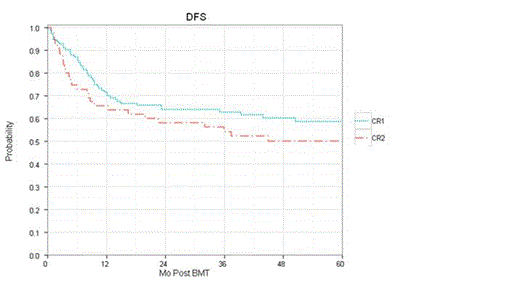Abstract
Allogeneic-HCT is recommended for AML patients (pts) in CR2, in CR1 with poor-risk cytogenetics, and should be considered for those in CR1 with intermediate-risk. Non-relapse mortality (NRM) and GVHD remain major causes of treatment failure. Ex vivo TCD can prevent GvHD but large case series have not been published.
A retrospective chart review was conducted to evaluate 178 pts with AML in CR1 and CR2 undergoing TCD-HCT between 2001 and 2011. All pts received myeloablative-conditioning. The majority received ATG for graft rejection prophylaxis. Acute (A) and chronic(c) GVHD were assessed by standard criteria. No GVHD prophylaxis was administered post-transplant. Soybean agglutination+sheepRBC rosetting (sRBCR) was used for BM TCD. CD34+ selection +/- sRBCR was used for PBSC TCD. Pt characteristics were compared using Pearson's chi-squared and Fisher's exact tests. Prognostic factors relating to overall survival (OS) and DFS, including age, gender, leukemia etiology, cytogenetic-risk group, donor-type, TCD-method, conditioning-regimen, HLA match grade, HCT-specific comorbidity index and immune reconstitution were evaluated using log-rank test statistics. Differences in cumulative incidence (CI) rates were evaluated using Gray's test. Cox proportional-hazards regression was used to further adjust for pt risk factors for OS and DFS.
Pt characteristics and outcomes are summarized in Tables 1 and 2. Median follow-up of survivors is 52 mo (12-134). 177 pts engrafted. One died pre-engraftment, 7 developed late graft-failure (GF), and 3 are alive after a 2nd HCT. One yr incidence of aGVHD was low (grade 2-4 13%, 3-4 3%). Only 1 pt developed cGVHD by NIH consensus criteria. Univariate association between CR status (1 vs 2), OS and DFS was not statistically significant (p=0.17 and 0.16, respectively). After adjusting for HLA status, age, sex, cytogenetic risk, and regimen, CR2 pts had an increased risk of death (HR: 1.90 (1.14-3.16), p= 0.014). In CR1 pts, cytogenetics was associated with relapse incidence (p=0.003) and was highest in patients with adverse cytogenetics (31%, 95%CI 16-48) and <10% in intermediate I-II risk pts. Overall CI relapse at 1 and 2 yrs was 13% and 16%, respectively. Causes of death were: relapse (n=29), infection (n=25), GVHD (n=7), organ toxicities (n=5), GF (n=2) and other (n=7).
Female gender was significantly associated with decreased OS and DFS (p<0.002 and 0.003, respectively). Two yr estimates of OS and DFS in females vs males was 51% vs. 71% and 49% vs. 69%, respectively. These differences were due to a higher NRM in females receiving the chemotherapy based regimen (p<0.001). Gender difference was not observed in pts receiving TBI-based regimens (p=0.599). This difference persisted after adjusting for other common prognostic factors in a multivariate model. For the entire group, 2yr OS and DFS was 67% and 62%, respectively. For CR1 pts, 2 yr OS and DFS was 70% and 64%, respectively (Fig.1).
These results support the use of TCD HCT in AML pts in CR. Durable DFS and long-term OS can be achieved with low rates of GVHD without compromising the graft-vs-leukemia effect.
No relevant conflicts of interest to declare.
Author notes
Asterisk with author names denotes non-ASH members.




This feature is available to Subscribers Only
Sign In or Create an Account Close Modal